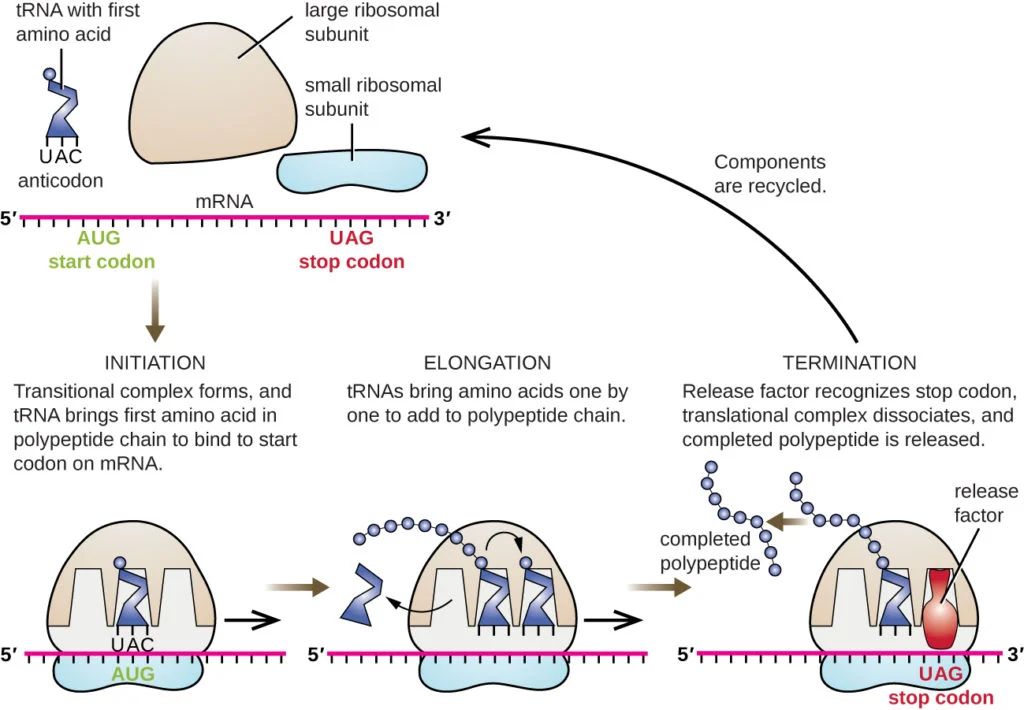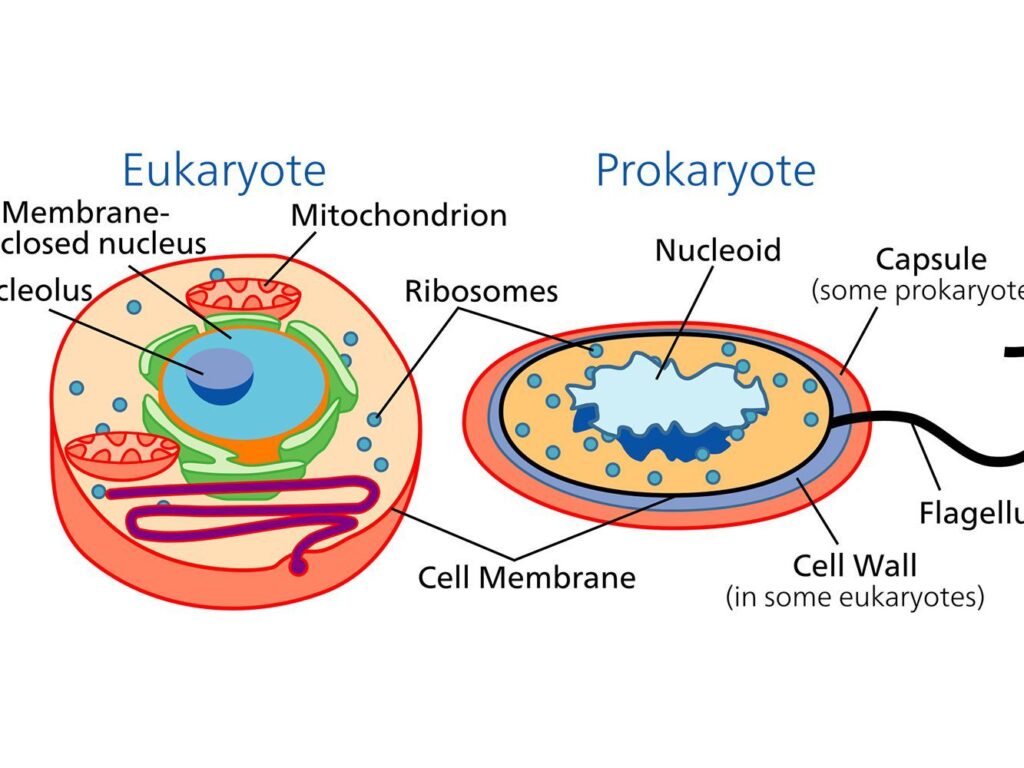Prokaryotes are simple, single-celled organisms that do not have a nucleus or other membrane-bound organelles inside their cells. Their DNA floats freely in the cell, and they include organisms like bacteria and archaea. They are among the oldest and smallest forms of life, but they play very important roles in nature and human health.

Life runs on proteins. From building cell walls to breaking down nutrients, proteins are the machines that keep all living organisms alive. But these proteins aren’t just floating around ready to use—they are made inside the cells using a beautiful process called translation.
In prokaryotes—simple organisms like bacteria—translation is incredibly fast and efficient. It helps them grow, divide, and adapt to changing environments almost instantly.
Let’s dive deep into this topic and understand how translation in prokaryotes works using simple words and easy-to-follow explanations.
Table of Contents
What is Translation?
Translation is the process of making a protein from a messenger RNA (mRNA) template. It is the second major step of gene expression, coming after transcription, where DNA is copied into mRNA.
Imagine your DNA is a cookbook. Transcription is like copying one recipe (a gene) onto a sticky note (mRNA), and translation is like following that recipe in the kitchen to make a dish (a protein).
Where Does Translation Happen in Prokaryotes?
In prokaryotes like E. coli, translation happens in the cytoplasm, which is the fluid inside the cell. Since these cells don’t have a nucleus, transcription and translation happen almost at the same time and in the same place. As soon as an mRNA strand starts being made, ribosomes can attach and begin translation.
This is one of the reasons prokaryotes can multiply so quickly—they don’t waste time!
Components Involved in Translation
Before we get into the steps, let’s meet the key players involved:
1. mRNA (Messenger RNA)
This carries the genetic message copied from DNA. It is a long chain of bases (A, U, C, G) organized in codons, or triplets, each of which codes for a specific amino acid.
2. Ribosomes
These are the cell’s protein factories. A prokaryotic ribosome has two subunits:
- Small (30S) subunit
- Large (50S) subunit
Together, they form the 70S ribosome (not additive due to sedimentation rates).
3. tRNA (Transfer RNA)
Each tRNA brings an amino acid to the ribosome and has an anticodon that pairs with the codon on the mRNA. It ensures the correct amino acid is added.
4. Amino Acids
These are the building blocks of proteins. There are 20 different amino acids, and they’re linked together in a chain to make a protein.
5. Enzymes and Protein Factors
- Initiation factors (IFs)
- Elongation factors (EFs)
- Release factors (RFs)
These help start, extend, and finish the process of translation.
The Genetic Code
The mRNA sequence is read in groups of three bases called codons. Each codon codes for one amino acid.
- AUG is the start codon (codes for methionine).
- UAA, UAG, UGA are stop codons (they don’t code for any amino acid but tell the ribosome to stop).
The code is universal, meaning it works the same way in almost all living organisms.
Stages of Translation in Prokaryotes
Translation happens in three main stages:

1. Initiation – Getting Started
This is like preparing the kitchen before cooking. Everything needs to be in place.
What happens:
- The small ribosomal subunit binds to the mRNA at a sequence called the Shine-Dalgarno sequence. This helps align the ribosome properly with the start codon (AUG).
- A special tRNA carrying formyl-methionine (fMet) binds to the start codon.
- The large ribosomal subunit then joins the complex, forming a complete ribosome.
Now we’re ready to begin making the protein.
2. Elongation – Making the Protein
Now we are building the protein one amino acid at a time.
What happens:
- A new tRNA with an amino acid enters the A site of the ribosome.
- The ribosome forms a peptide bond between the amino acid in the P site and the new one in the A site.
- The ribosome then shifts forward (this is called translocation), and the tRNA in the P site moves to the E site (exit) and leaves.
- This process repeats, adding amino acids one by one to grow the protein chain.
Sites of the ribosome:
- A site – Accepts new tRNA.
- P site – Holds the growing protein.
- E site – tRNA exits here.
This step is helped by proteins called elongation factors (EF-Tu, EF-G).
3. Termination – Ending the Process
Every good recipe has a finish line. Here’s how translation stops:
What happens:
- The ribosome reaches a stop codon (UAA, UAG, or UGA).
- Since no tRNA matches a stop codon, a release factor (RF) binds.
- The newly made protein is released, and the ribosome breaks apart.
- The components can be reused to start translation again.
Polysomes – Efficiency at Work
In prokaryotes, multiple ribosomes can attach to the same mRNA and make many copies of a protein at the same time. This structure is called a polysome.
It’s like many cooks using the same recipe at once to make several dishes quickly.
Speed and Accuracy of Translation
Prokaryotic translation is incredibly fast—up to 20 amino acids added per second! Despite the speed, the process is also very accurate, thanks to proofreading by tRNA and ribosomal proteins.
Even a tiny mistake in the sequence could lead to a broken or harmful protein, so cells are careful.
Medical Importance – Antibiotics and Translation
Many antibiotics work by targeting bacterial translation without affecting human cells.
Some examples:
- Streptomycin – causes the ribosome to misread mRNA.
- Tetracycline – blocks tRNA from entering the ribosome.
- Chloramphenicol – stops peptide bond formation.
Understanding bacterial translation helps scientists design new antibiotics and fight infections more effectively.
Translation vs. Transcription
| Feature | Transcription (DNA → mRNA) | Translation (mRNA → Protein) |
|---|---|---|
| Location | Cytoplasm | Cytoplasm |
| Template | DNA | mRNA |
| Product | mRNA | Protein |
| Enzyme/Tool | RNA Polymerase | Ribosome + tRNA |
| Base pairing | A-U, G-C | Codon-anticodon matching |
Differences Between Prokaryotic and Eukaryotic Translation (Quick Comparison)

| Feature | Prokaryotes | Eukaryotes |
|---|---|---|
| Ribosome Size | 70S (30S + 50S) | 80S (40S + 60S) |
| Initiator tRNA | Formyl-methionine (fMet) | Methionine (Met) |
| mRNA Features | Shine-Dalgarno sequence | 5’ Cap and Poly-A tail |
| Location | Cytoplasm (alongside transcription) | Cytoplasm (after nuclear transcription) |
| Translation Speed | Fast | Slower |
Importance of Translation in Prokaryotes
- Fundamental for life – It’s how genetic information becomes useful.
- Helps bacteria grow fast – Allows quick response to environment.
- Target for antibiotics – Crucial for medicine and public health.
- Used in genetic engineering – Scientists use bacteria to produce proteins like insulin, enzymes, and vaccines.
CONCLUSION
Translation in prokaryotes may seem like a small cellular event, but it’s truly powerful. It turns plain genetic code into life-sustaining proteins. By studying this process, we understand not only how bacteria live and grow, but also how we can use this knowledge to fight disease, develop medicines, and create amazing innovations in science.
FREQUENTLY ASKED QUESTION
What is prokaryotes ?
Prokaryotes are simple, single-celled organisms that do not have a nucleus or other membrane-bound organelles inside their cells.
What is Translation ?
Translation is the process of making a protein from a messenger RNA (mRNA) template. It is the second major step of gene expression, coming after transcription, where DNA is copied into mRNA.
How is a prokaryotic different from a eukaryotic cell ?
A prokaryotic cell is a simple, small cell without a nucleus or membrane-bound organelles, while a eukaryotic cell is larger and more complex, with a true nucleus and specialized organelles.
Related Articles




